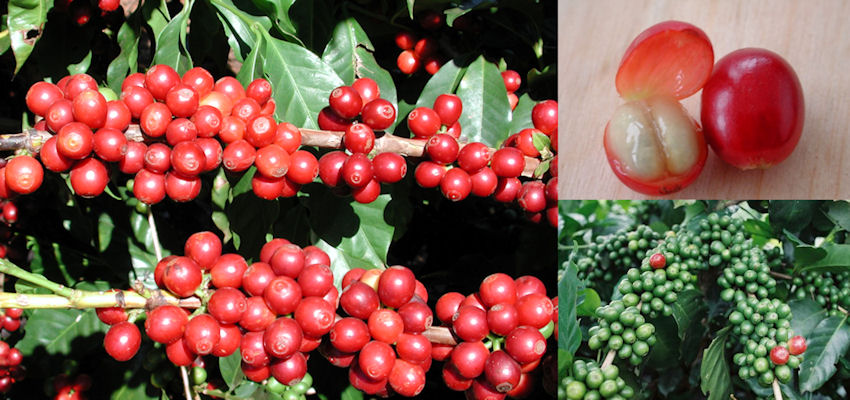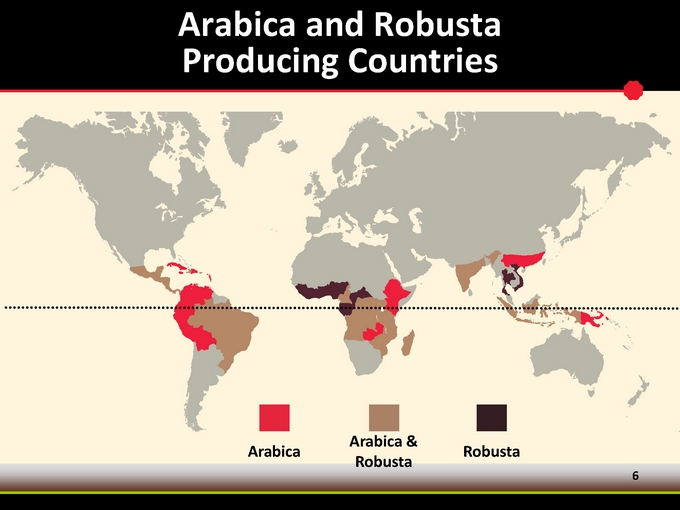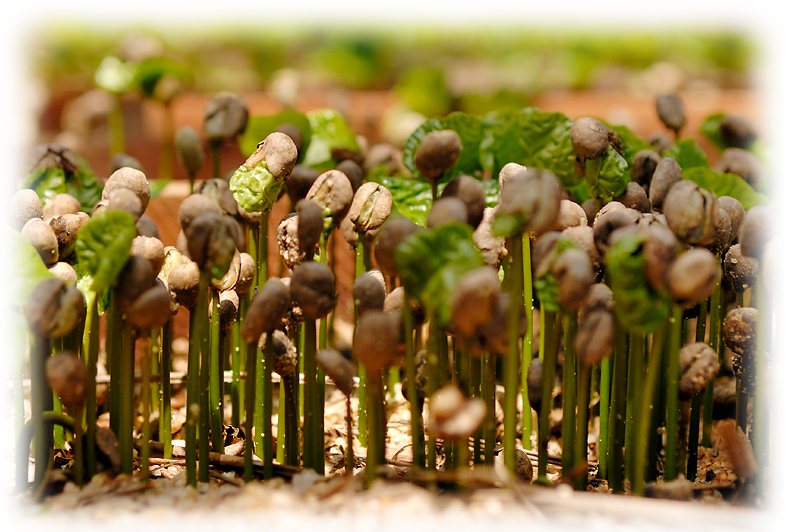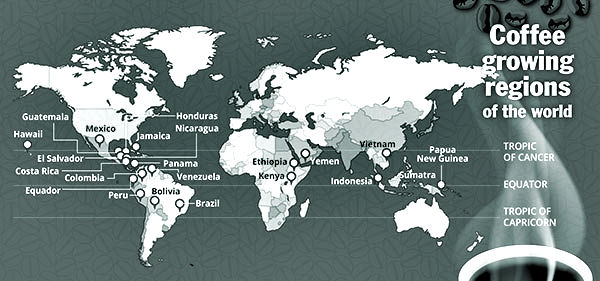
Coffee Bean Origins
Coffee beans are not really beans but the seed of a cherry like fruit that is produced by a flowering shrub commonly referred to as a coffee tree. There are two main varietals of coffee trees, Arabica and Robusta.
Arabica beans tend to have a sweeter, softer taste, with tones of sugar, fruit, and berries. Their acidity is higher, with that winey taste that characterizes coffee with excellent acidity.
Robusta, however, has a stronger, harsher taste, with a grain-like overtone and peanutty aftertaste. They contain twice as much caffeine as Arabica beans, and they are generally considered to be of inferior quality compared to Arabica. Some robustas, however, are of high quality and valued especially in espressos for their deep flavor and good crema.
Most of the specialty grade coffees sold today are from trees belonging to the Arabica family. Coffee trees grow in the equatorial zone all around the world and the best coffees are produced from countries that have rich volcanic soils and higher elevations.
Coffee producing countries are:
- Australia
- Bolivia
- Burundi
- Brazil
- Cameroon
- Colombia
- Costa Rica
- Cuba
- Democratic Republic of the Congo
- Dominican Republic
- El Salvador
- Ecuador
- Ethiopia
- Guatemala
- Guinea
- Haiti
- India
- Indonesia
- Ivory Coast
- Jamaica
- Kenya
- Kukgar
- Madagascar
- Malawi
- Mexico
- Nepal
- Nicaragua
- Panama
- Papua New Guinea
- Paraguay
- Peru
- Philippines
- Rwanda
- Tanzania
- Thailand
- Timor
- Togo
- Uganda
- United States of America, Hawaii, Puerto Rico
- Venezuela
- Vietnam
- Yemen
- Zambia
- Zimbabwe

There are many variables that will dictate how coffee will taste once it has been roasted. One of the biggest indicators of how coffee will taste is the region or country in which it is grown. Each producing region has unique conditions that influence the flavours of the coffee.
American coffees are grown all along the mountainous backbone of Latin America, from southern Mexico south through Central America, Colombia and Bolivia to Peru, as well as in the highlands of the larger islands of the Caribbean and on the high plateaus of Brazil. At their best, the classic coffees of Latin-American manifest bright, lively acidity and clean.
The very highest grown coffees of Central America and Colombia tend to be boldly and intensely acidy and full-bodied. Caribbean coffees, including the celebrated Jamaica Blue Mountain, tend at their best to be big-bodied and roundly balanced with rich, low-key acidity. The best Nicaraguan coffees are meaty and full-bodied. Lower grown coffees from Central America tend to be soft and round in profile, as are the often exquisitely sweet coffees of Peru.
The character of the classic Latin-American coffees, in part, derive their clarity of flavour through wet-processing. The coffees of Brazil offer a different world of experience based on a much wider variety of processing methods, from dry-processing, which produces the classic Brazil Santos cup, low-toned, spicily complex and rich, to semi-dry or pulped natural processing, which promotes a softly complex, delicately fruity cup, to classic wet-processing, which produces a cleanly understated, pleasingly low-acid cup much like the one offered by the finer lower grown coffees of Central America.
Some of the world’s most distinctive coffees are grown in East Africa along a long north-south axis that starts at the southern tip of the Arabian Peninsula in Yemen and concludes in Zimbabwe in southern Africa, along the way encompassing the highlands of Ethiopia, Kenya, Tanzania, Zambia, and several less prominent origins.
These coffees are characterized by a variety of floral and fruit notes, from the floral and citrus character of Ethiopia wet-processed coffees through the intensely acidy and berry-toned Kenyans to the soft and fruity Zambians. This family of coffees includes two of the world’s oldest and most traditional origins: the Harrar coffees of north-eastern Ethiopia and the coffees of Yemen. These coffees are picked and put out to dry on rooftops, fruit and all and both display variations on a complex, slightly fermented fruitiness.
Pacific coffee origins are grown in the Malay Archipelago, that chain of often enormous islands that make up the nations of Indonesia, Timor and Papua New Guinea. These coffees include the deep-toned traditionally processed coffees of Sumatra, Sulawesi and Timor, with their complex fruit, earth, and musty notes. By contrast, wet-processed coffees of Sumatra, Java, and Papua New Guinea are bright and floral and may range from delicate to (in the case of some Papua New Guineas) intensely and fragrantly acidy.
Arabica coffees from India tend to be sweet, floral and low in acidity. India is also the source of the world’s finest coffees of the Robusta species, the wet-processed Parchment and Kaapi Royale Robusta, and the exotic Monsooned Malabar, a dry-processed coffee that is exposed to moisture-laden monsoon winds for several weeks, this exotic process mutes acidity, deepens body, and adds a malty mustiness.
Hawaiian coffee the celebrated coffees of Kona resemble the finest Central America coffees, with a classically clean, transparent cup that can range from powerfully acidic and bright to soft and delicate. The coffees of the island of Kauai are round, balanced, and low in acidity owing to low growing altitudes. The island of Molokai produces two distinctive coffees, a wet-processed Malulani Estate remarkable for its spicy pipe-tobacco tones, and the dry-processed Molokai Muleskinner, a rather rough, unpredictable coffee that often displays mild musty and fruit ferment notes.

The tree of Coffea arabica will grow fruits after three to five years, and will produce for about 50 to 60 years (although up to 100 years is possible). The white flowers are highly scented. The fruit takes about 9 months to ripen.
Raw unroasted coffee beans are typically green to yellow in color and commonly referred to as green coffee beans. The coffee roasting process is what brings out the rich brown colors that most people associate with coffee. Green coffee beans can be stored for long periods of time if keep cool and dry.



